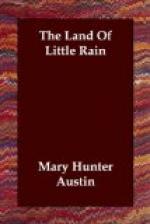On, down from the lower lakes to the village weirs, the brown and golden disks of helenum have beauty as a sufficient excuse for being. The plants anchor out on tiny capes, or mid-stream islets, with the nearly sessile radicle leaves submerged. The flowers keep up a constant trepidation in time with the hasty water beating at their stems, a quivering, instinct with life, that seems always at the point of breaking into flight; just as the babble of the watercourses always approaches articulation but never quite achieves it. Although of wide range the helenum never makes itself common through profusion, and may be looked for in the same places from year to year. Another lake dweller that comes down to the ploughed lands is the red columbine (C. truncata). It requires no encouragement other than shade, but grows too rank in the summer heats and loses its wildwood grace. A common enough orchid in these parts is the false lady’s slipper (Epipactis gigantea), one that springs up by any water where there is sufficient growth of other sorts to give it countenance. It seems to thrive best in an atmosphere of suffocation.
The middle Sierras fall off abruptly eastward toward the high valleys. Peaks of the fourteen thousand class, belted with sombre swathes of pine, rise almost directly from the bench lands with no foothill approaches. At the lower edge of the bench or mesa the land falls away, often by a fault, to the river hollows, and along the drop one looks for springs or intermittent swampy swales. Here the plant world resembles a little the lake gardens, modified by altitude and the use the town folk put it to for pasture. Here are cress, blue violets, potentilla, and, in the damp of the willow fence-rows, white false asphodels. I am sure we make too free use of this word false in naming plants—false mallow, false lupine, and the like. The asphodel is at least no falsifier, but a true lily by all the heaven-set marks, though small of flower and run mostly to leaves, and should have a name that gives it credit for growing up in such celestial semblance. Native to the mesa meadows is a pale iris, gardens of it acres wide, that in the spring season of full bloom make an airy fluttering as of azure wings. Single flowers are too thin and sketchy of outline to affect the imagination, but the full fields have the misty blue of mirage waters rolled across desert sand, and quicken the senses to the anticipation of things ethereal. A very poet’s flower, I thought; not fit for gathering up, and proving a nuisance in the pastures, therefore needing to be the more loved. And one day I caught Winnenap’ drawing out from mid leaf a fine strong fibre for making snares. The borders of the iris fields are pure gold, nearly sessile buttercups and a creeping-stemmed composite of a redder hue. I am convinced that English-speaking children will always have buttercups. If they do not light upon the original companion of little frogs they will take the next best and cherish it accordingly. I find five unrelated species loved by that name, and as many more and as inappropriately called cowslips.




